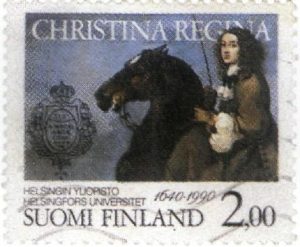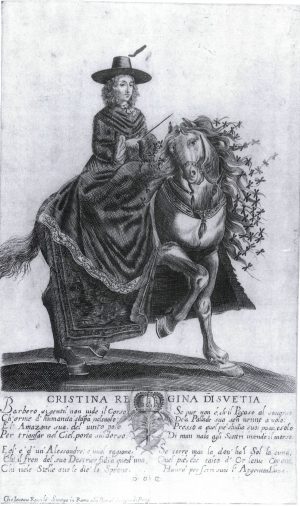
Queen Christina (1626-1689) was the reigning queen of Sweden between 1644 and 1654. Her reign ended when she abdicated, after which she converted to Catholicism – an action which has greatly tasked historians in their attempts to offer an explanation. Christina spent the greater part of her remaining years in Rome. Her interest in cultural and scientific topics started at an early age, and she associated and corresponded with a number of the most eminent scholars of the era.
Christina’s literary works consist of two collections of aphorisms, an autobiography, two essays – one on Alexander the Great and one on Julius Caesar – and her letters. The Queen did not publish these works during her lifetime. They were first published by Johan Arckenholtz in Mémoires concernant Christine, reine de Suède, pour servir d’éclaircissement à l’histoire de son regne et principalement de sa vie privée (1751-1760; Memoirs of Christina, Queen of Sweden, to Shed Light on Her Reign and Especially Her Private Life). Christina wrote in French, the language used by educated people of the day.
Maxims on God and the Heroic Human
A maxim, or aphorism, is a short and succinct formulation of a fundamental principle generally accepted as self-evident or wise. The genre was first used in antiquity. One of the most renowned aphorists was a contemporary of the queen, François de La Rochefoucauld. Christina read and commented on his maxims, but she also wrote her own, most likely over a lengthy period of time, and they therefore reflect her intellectual and religious development. They survive in a fair copy from the 1680s, in which she has crossed-out passages and made additions. Christina’s maxims do not have the pithy formulation characteristic of La Rochefoucauld’s, and they are chiefly interesting on account of the picture they give of their author. Like other aphorists, Christina’s wisdom is not consistent, but contains a good many contradictions. In the maxims dealing with God and our relationship with God, Christina stresses God’s sublimity and states that he alone can satisfy the soul and that he alone is worth loving:
“A God, who is the only principle and ultimate goal of all things, unequivocably exists.”
“This God is incomprehensible and ineffable.”
“We must love him and worship him, simply because he is God.”
“When we plumb the depths of our heart, we find that nothing is capable of filling it and nothing comforts it but God alone.”
It seems that Christina attributes to certain people a special ability to love, when she writes:
“A heart that has the capacity to love will inevitably love God sooner or later.” Elsewhere she writes: “A person who really loved God would never forget him.”
Christina also points to the Roman Catholic denomination as the true faith. It is interesting to note that Christ plays no role in the maxims. Immortality of the soul is a prerequisite for life and death to be of value. God has recommended virtue. The path of virtue should be followed for its own sake, but there should be no expectation of individuals rewarding virtue with gratitude for the kindnesses they have received. It would seem that for a large part of her life Christina applauded the Stoic teachings on virtue, and was in no doubt that humankind could live up to this doctrine of righteousness.
Stoic virtue is to live and act according to nature. Nature, that is, human nature, was defined as ‘reason’. To live according to one’s inherent nature, in other words to live according to reason and virtue, is to be happy and good. It is injudicious, bad and reprehensible to be affected by ‘passion’, that is, strong emotions.
Some of her maxims, however, contradict this view of human nature:
“Man is an abyss of misery and ignorance who knows neither his body nor his soul. But he feels that his is a veritable nothing appareled in a thin cloak of life, and that knowledge, allied with all of the world’s philosophy, can neither change nor improve him.”
It would only seem reasonable to assume – as was earlier the case – that Christina abandoned Stoicism, which lost influence in Europe over the course of the century. Towards the end of her life she adopted a Quietist approach to religion, which, with its emphasis on human impotence, was not particularly compatible with the Stoic doctrine of virtue.
Quietism (from Latin quies: quiet, rest) is a form of mysticism that emphasises the expurgation of all desire from human will. Through meditation and contemplation it is possible to annihilate one’s own will and be absorbed into God. The seventeenth-century Roman Catholic Church considered this movement heretical, primarily because of its indifference to the Church and its ‘passive’ approach: Quietists rejected the idea that one should make any effort to reach God through a devout life. The leading figure of the movement, the Spanish priest Miguel de Molinos, was very close to Christina. In 1687 he was convicted of heresy.
Christina was a great admirer of Alexander the Great and Julius Caesar; they were both ‘heroic humans’. The great princes, whom she sees as God’s representatives, belong in this category. They are particularly gifted by nature and not even their faults are any impediment to their greatness:
“If Julius Caesar, Alexander the Great and Cyrus the Great managed to conquer and rule much of the world in days gone by, it was because they possessed the larger-than-life qualities that such heroism demands, and because the very nature of their times called it forth.”
Of Alexander’s faults, Christina writes: “They were only spots on the sun and did not stop him from being who he was… none of his monumental shortcomings, not even his criminal acts, could stand in the way of his being the world’s greatest prince, for he was nevertheless a human being.”
It is everyone’s duty to try to imitate these heroic people. Christina considered herself to be in this category.
Autobiographical Contradictions
The maxims bring to light the contradictions in Christina’s view of human nature. On the one hand, she thinks that humankind can and should improve itself and make progress; on the other hand, she sees humankind as impotent, corrupt and fundamentally ignorant. Once she tackles the writing of history – her own and that of the Vasa lineage – other contradictions emerge. What is it that controls events: God’s plan, human calculation, chance or persona; and what has she herself been: woman or man, or neither?
Christina called her autobiography La Vie de la Reine Christine, faite par Elle–Même, dediée au Dieu (The Life of Queen Christina, written by herself, dedicated to God). Surviving versions of this text allow us to follow the writer’s changeable perspectives via the various additions and deletions. The autobiography – written in 1681 – was never completed, and the extant torso consists of nine chapters in which we can read about the geography and history of Sweden, the lives of the Vasa kings, and the young Christina. And that is as far as the by and large chronologically arranged text goes; we search in vain for an account of that which is of greatest interest to posterity: her abdication and religious conversion.
In the prelude to the autobiography – a dedication of the work to God – the text echos the Quietist prayer issuing from the impotence and vanity of humankind when compared with the omnipotence and glory of God. This is followed, without further ado, by an account of Sweden’s geography and a historical review of Sweden and the Vasa kings in particular. When she eventually gets around to her own life, her style of presentation is that of the ‘literary portrait’ genre, spending just a few lines to give an outer and inner description of her person. Diverse interpretations of the individual and the life are attached to these diverse discourses, and in the conflict between interpretative models we perceive something that the writer has not overtly expressed.
To begin with, the autobiography gives a picture of an individual apparently split into two people. She is partly Christina, who according to the Quietist model sees herself as nothing, and who prays to God: “Annihilate everything that is not from You.” At this juncture in the first version, Christina used the Quietist term “holocauste”, annihilation, total sacrifice to the glory of God. And she is partly – or she has been in the historical chapters – a Vasa descendant and commander of the “götiske” (Geatish, i.e. Swedish) people, conqueror of Rome.
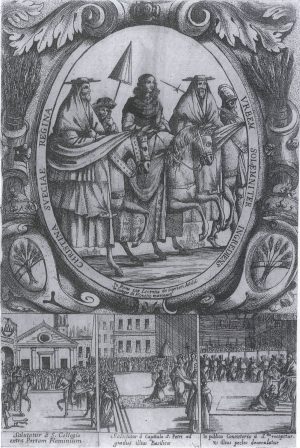
She describes her warlike people with undisguised pride: “With its victorious weapons, this people subdued Germany, followed by England, France and Spain, and even glorious Italy must ultimately fall under its yoke, not to mention much of Asia and Africa.” We must remember that her father, Gustaf II Adolf, had been a zealous advocate of “göticismen” (Gothicism), and that Christina herself had once made a splendid entrance into Rome. She might somehow have seen herself as her father’s superior, given that she had actually ‘conquered’ Rome.
Since the Late Middle Ages, the Swedes had associated the Goths, conquerors of Rome, with the Swedish tribe of Götar (Geats). In the seventeenth century this idea was keenly encouraged by the powers-that-be; for example, a writer who demonstrated that the Götar were an extremely old and venerable people could count on subsidy from the Crown.
This division in the text does not apply exclusively to its topics and manner of presentation. It also applies to diametrically different ways of perceiving humankind and history. The religious discourse depicts Christina as chosen to be sacrificed to the glory of God and God’s plan for her, whereas the historiographical discourse provides rational explanations of what happens and views humankind as being in the driver’s seat of life. Her descriptions of the history of Sweden and of the Vasas identify power struggle and raison d’état as the fundamental causes of the course of events.
These two interpretative models sometimes come into conflict in the text. We can sense traces of the religious model’s explanation – it is God’s will that these heretics introduce Lutherism into Sweden and promote its dissemination in Germany – but this explanation was just a bit too stiff. And just as stiff, in fact, was the explanation that God had no role in the matter, but that what ultimately shaped developments was power struggle and raison d’état. The latter explanation was disgreeable to Christina for another reason: it weakened the ideological foundation of Vasa power, given that in those days the possession of power was nearly always justified with help from God’s Providence. Legitimacy was of extreme importance to Christina, as can be seen by, for example, the many revisions she made in her telling of the history of the Vasa kings. In one of the extant versions, she solved the conflict by referring to fortune or fate. She employed, in other words, an explanation that does not actually give an explanation: “Ever since we [the Vasa lineage] became regents, people have hastened to persuade us that we were sired by Erik Segersäll, but it makes no difference. Everyone knows that when fortune or fate elevates people, their family tree grows like a mushroom.”
A similar explanatory model also intervenes in her depiction of her own life: in the rise and fall of the Vasa lineage she sees the workings of God’s punishment. The fall is the fact that the lineage now, this being 1681, rules neither in Poland nor in Sweden. Christina’s abdication is the sacrifice of the innocent to atone for the crimes of the family line. We can glimpse the noble self-sacrificing heroines of French classical tragedies behind this self-portrait, as well as the Quietist elevation of sacrifice and annihilation of mortal glory. In one of the versions we read:
“I was the only heir to the Swedish throne, for which my forefathers and antecedents had performed so many great and illustrious deeds, interspersed with many crimes and betrayals, whose effacement may be the reason for my continued existence. Lord, you have sought to punish us justly at our own hands by letting brother wipe out brother, uncles slaughter nephews, one after the other. All of our greatness has finally vanished. The last two regents renounced power voluntarily, in both Poland and Sweden, albeit at different times, in different ways, for totally different reason – and with different consequences, as you well know. All of them are dead now. Only I have endured.”
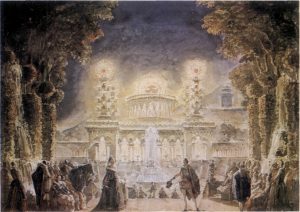
God’s plan, the struggle for power and the concept of ‘blind fate’ are the three mainsprings Christina has wished to see in the machinery of history. When she goes deeper into her story, a fourth can be added: personality. The personalities of her father, mother and entourage are here described with an incisive pen. The portrait genre dominates. In line with the fundamentally psychologising view of this genre, the inner development of the character and the individual now explain the course of events. Judging from the large number of additions and deletions we find in this context, it is at this point that the question of Christina’s femininity, the enigma of her identity, becomes urgent. In her religious model, the riddle can be posed thus: why has God chosen that she be born female given that He has chosen to let her be sacrificed to His glory? The greater the sacrifice, that is, the amount of earthly happiness, honour and dignity sacrificed, the greater is God’s glory. And for Christina, as well as for her contemporaries, the sacrifice would have been greater had she been a man.
Christina’s thoughts on women and their status were typical of her times. In her maxims, and elsewhere, she makes it quite clear that woman is the weak sex, and that she is inferior to the man in both body and soul. This was also the opinion of the Church and must be seen as the prevailing mindset of the times. In Christina’s opinion, however, there could be exceptions: “The weakness of the female sex does not always extend to the soul.” The weakness is not always determined by nature, but also depends on upbringing: “Temperament and upbringing give rise to the entire difference between the sexes.”
Christina also thought men’s temperament to be warmer and drier than that of women, who were colder and moist. The latter was not good because it gave rise to weaknesses. Christina certainly believed that upbringing could achieve a lot, but not that it could correct the ‘aberration of nature’ that was being of the female gender. It was a substantial obstacle on the path of virtue and worth, and an almost incurable fault because only a small number succeeded in rectifying it.
The autobiography demonstrates a real contempt of women. In this respect the portrait of her mother, Maria Eleonora of Brandenburg, is the most malevolent, and an addition from Christina’s hand shows her evident dislike of female conduct:
“Their apparel, adornmnets and expressions are unberable to me. I never wear a hat or a mask; I have no concern for my skin, the proportions of my body, or my body in an any other respect. I defer to the dictates of femininity only when it comes to being clean and courteous. I cannot abide long vestments, I want to wear only short dresses, particularly in the countryside.”
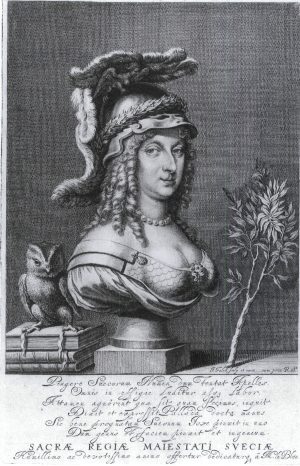
In another addition Christina writes about how she was brought up as a young Spartan, an ideal later reinforced by her reading of the heroic biographies of antiquity – Plutarch’s biographies, for example – and by the glorification of the Amazon and the maiden as promoted by “preciösernas” (les précieuses):
“Children of both sexes and of my age were brought together throughout the castle to play with me; my joy was to run, skip, dance, etc. But I could never stand dolls, and I had to draw on all my prudence not to hate an honourable man who gave me a magnificent present of that species. My dolls were pieces of lead with which I learned how to wage war. These pieces formed a little army that could be lined up for battle on a table with its retinue of a complete artillery. I had small ships that were equipped for war, small forts of thick paper – all to teach me everything I needed to know about war, the navy and the science of fortifications. I revelled in these trifles during my leisure hours and the days when I did not devote myself to more serious studies. In all my games and diversions, my feelings were powerful and impetuous, and everything I desired called forth my persevance and strength. But I was reasonable and conciliatory whenever someone could persuade me that I had been mistaken.”
At the age of eight Christina was removed from her mother – a woman thought unsuitable as mentor for the future sovereign – and was from that time brought up by men. The powerful men running Sweden at the time seemingly considered Maria Eleonora to be half-deranged, or at least of little intelligence and prone to hysterics, and this picture of the Queen Dowager must have contributed to Christina’s disdain for women.
At the time, an oft-cited argument against female influence in society was that Salic law excluded women from the line of succession.
Salic Law, lex salica: a law written around AD 500 for the Salian Franks. The most well-known clause prohibited females from inheriting land. In high medieval France, during the Hundred Years’ War, this was interpreted as a ban on women inheriting the throne. The term “Salic law” often simply refers to agnatic succession.
Christina agreed with this law, and that women’s faults, as well as their merits, made them unfit to be sovereigns. Her maxims also refer to women’s status: an unenviable situation, given that she is either prisoner or slave. The women who have entered a convent are prisoners; the women who have married are slaves; and those were the two choices for women in the upper social echelons of Catholic countries.
Christina had no high opinion of marriage. People marry without knowing one another, love and marriage are virtually incompatible, the pleasures of marriage cannot compensate for the negative aspects, and it takes greater courage to get married than to march off to war. Love, however, is a different matter: “The heart was made to love.”
“If love is weakness, it is the only kind of weakness that must be forgiven, even in the most heroic of people.”
Great demands are made of true love. The object of one’s love must be worthy of that love. Love must be constant and hold its own against external impediments. It is not the same as sensual pleasure. Christina’s thoughts on love are no doubt influenced by her contemporaries, the French précieuses, who express similar ideas in their writings and who, like Christina, took a sceptical stance on marriage.
The French female culture of préciosité dominated the Parisian salons of the mid-1600s. Les précieuses preferred the tender and noble friendship to the passionate love and patriarchal marriage. Their vision of utopian friendship had great influence on eighteenth-century Nordic women’s literature, as it did on Queen Christina’s understanding of love and her desire to avoid the traditional life of a woman.
One difference between them is that Christina has a religious perspective on all forms of love. God is the true object of love, the soul is created to love and possess Him for ever. Love between man and woman is an imperfect image of this love. In her autobiography we come across similar trains of thought. Added to her disdain for women there is a clearly defined aversion to the physical aspect of love. Whether this aversion is deeply personal, or is a mental attitude of préciosité, or both, we cannot say:
“I would certainly have married had I detected the slightest weakness in myself; because, however, I experienced the strength that your mercy conferred on me to shun even the most legitimate pleasures, I have obeyed my natural aversion to marriage.”
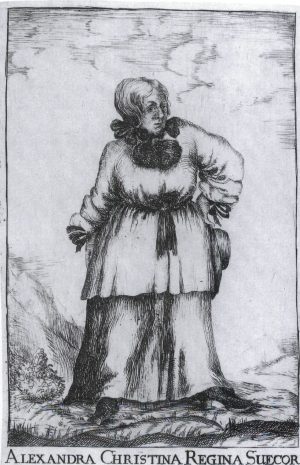
Christina saw herself as being of a dual nature. She thought that she had a male soul and also, in part, a male body. She also thought that she had a warm – meaning male – temperament, and thus resembled a man as much as was possible for a woman. We are familiar with her account of her birth: at first the midwife believed her to be a boy. Christina’s attitude to femininity can be interpreted as a means of reconciling the religious with the rational explanation of her abdication and conversion. The religious explanation was that God had chosen her to be sacrificed to His glory; the psychological explanation was that on account of her strangely dual gender identity and her “insurmountable aversion to marriage” she could not provide Sweden with an heir to the throne, and could therefore be instrumental in pitching crown and country into political chaos. Christina may have intended to construct an account of her abdication based on this resistance: the fact that she was born female could then be given a meaningful spin.
That Christina is here close to the historical ‘truth’ is corroborated by the first surviving testimony from this complex chain of events: her well-known statement to the National Council in 1649. On February 26 she said:
“But that I have been urged to marry is a matter with which I have difficulty reconciling myself, for I would never be free but shackled and could never escape.”
The next day, the Council minutes reported:
“Her Majesty finally spoke about her marriage, and one could easily see that Her Masjesty’s eyes and nose sit too high in her face to surrender to the power of a man in the state Her Majesty now finds herself.”
Christina’s aversion to getting married and producing an heir to the throne was most likely only one of the reasons for her abdication, and perhaps not the most pressing. She eventually managed to secure acceptance of her cousin, Karl Gustaf, as her successor, and by so doing she thought that she had made provisions for the security of the realm. Other reasons were presumably that she was tired of ruling and that she wished to convert. However, the first evidence of her Catholic orientation did not emerge until 1651, two years after she definitively – aged twenty-three – rejected the possibility of marriage. In her autobiography Christina reconciled the religious and the psychological explanations by pointing up her singular character and her aversion to “sensual pleasure”. In these features of her person, God had acted for the redemption of her soul and to His own glory.
Christina writes her autobiography with the pen of rationality. Her main concern has been to explain what occurred. Whether this explanation has been theological, historical or psychological has been of secondary importance. Nothing has been left unexplained, enigmatic or meaningless: her words display a manifest fear of the conundrum void, a fear that causes her to push her analysis of the mainspring of events so far that she sees her gender identity and her relationship to sexuality as the crankshaft around which her life revolves. The voice that bid her answer ‘why’ must have been very commanding and strict indeed.
Translated by Gaye Kynoch


